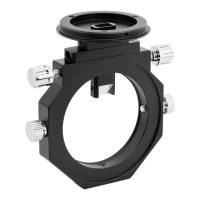10 11
c. Thread the StarShoot Autoguider onto the T-threads of the guider
platform and the TOAG body onto a filter wheel (if being used) or the
2" nosepiece adapter for attaching the unit to a telescope, as shown in
Figure 9.
3. Adjusting the Autoguider On the TOAG
When your main camera and autoguider are installed and the TOAG is con-
nected to your telescope, you are ready to adjust the distance between the auto-
guider and the TOAG.
How to Adjust the Autoguider Distance
Because the pick-up prism only intercepts a small portion of the light coming
from the telescope, finding a guide star without interfering with the main camera
view can sometimes be challenging. To familiarize yourself with an off-axis guider
we suggest that the initial distance adjustment should be set during daytime.
a. Start by focusing the main camera. Use the telescope’s focuser; we
suggest using a distant terrestrial object as target. This ensures that the
obtained focused image is at a focuser barrel position close to infinite
focus (star focus position).
b. Although the distance from the main camera to the TOAG is
approximately the same from the autoguider sensor to the center of the
TOAG you may need to refine this distance (using optional spacer rings).
c. Compare the obtained main camera image to the autoguider image.
The autoguider image might be out of focus. If so, loosen the upper
two prism tube stabilization setscrews and the two lateral setscrews
adjacent to them (refer to Figure 2). This allows you to move the guider
platform up or down a few millimeters – without moving the prism tube.
Move the guider platform up or
down until you reach focus (if
possible). Then re-tighten the
four setscrews.
d. If the focus is further in you
should add some spacing to
the main camera side. If it
is further out you will need
to add a spacer between
the guide platform and your
guide camera, as depicted in
Figure 10.
4. Debunking Off-
Axis Guider Myths
How Does Autoguider Focus Affect the Guiding Performance?
It is not required to get razor sharp focus with the autoguider camera. Most
autoguiders have a very small pixel size. The algorithm used for guiding takes
into account the centroid of the star. Some people even find that better results
are achieved when slightly defocused guide stars are used.
However one should try to get a fairly focused image so that the star flux is high
against the background. Autoguider sensitivity plays an important role in this
matter.
Off-Axis Guiders Are Less Sensitive than Guidescopes?
The answer is no and… yes. Yes, because you only get a tiny portion of the light
cone from the telescope. But then again you are getting the pick-off prism light
from a fairly larger aperture (telescope aperture) compared to what you would
get with a guidescope.
A 6" aperture telescope with an OAG will always show more guide stars than a
50mm guidescope.
Finding Suitable Stars with an Off-Axis Guider Is Difficult!
Autoguider sensitivity plays a major role in finding suitable guide stars, more
than the off-axis guider itself. There are more pros than cons with an OAG.
Telescope differential flexure is compensated only with an OAG. But there’s also
the camera, focuser, adapter flexure and any other variables between the OAG
and the telescope to consider. With the OAG all these variable are under control.
Figure 10. Adding a spacer to get
optimum distance
Figure 9. StarShoot G3 camera with StarShoot Autoguider

